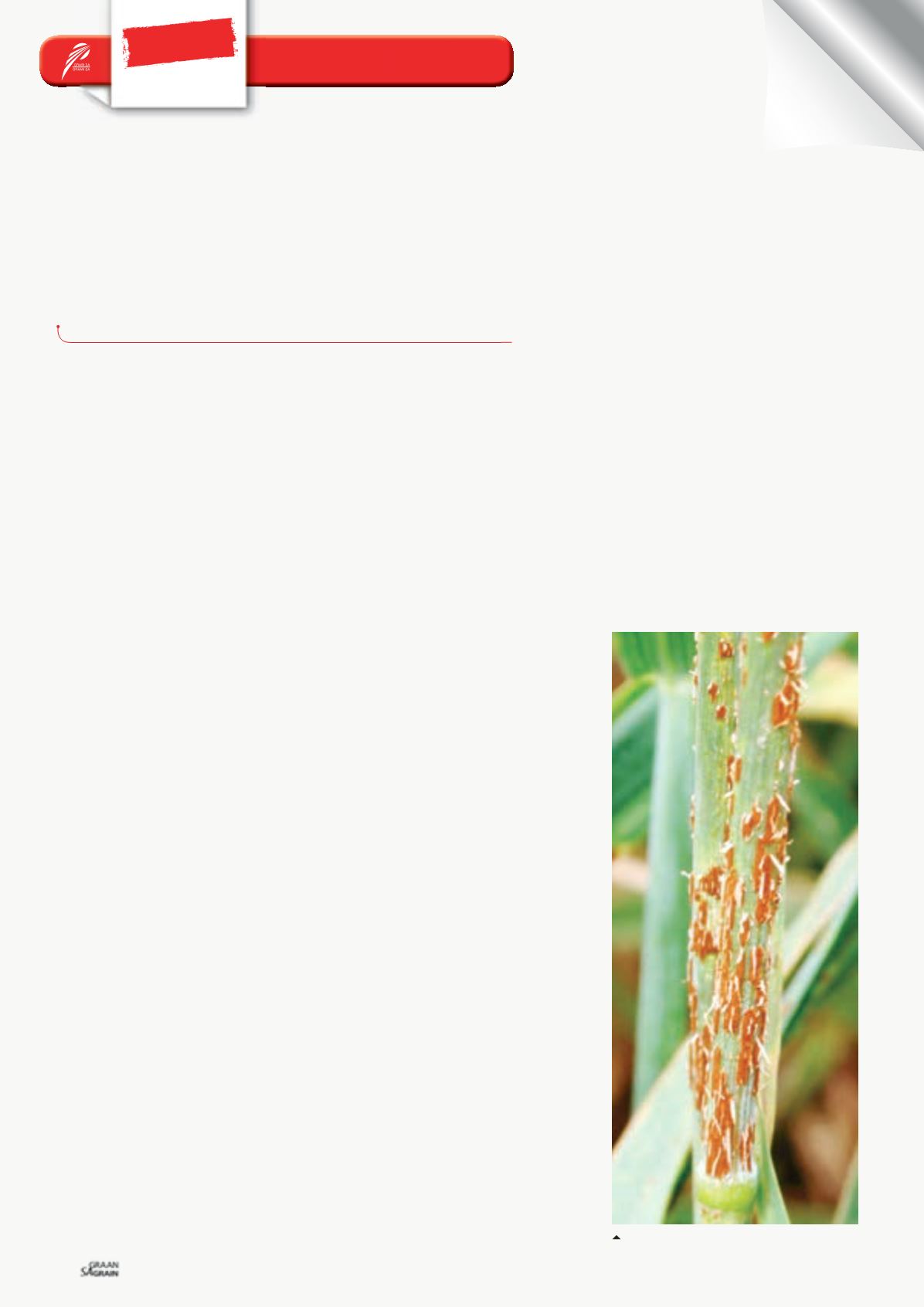

FOCUS
Integrated pest control
Special
Potentially dangerous Ug99 stem rust
evolving and spreading through Africa
U
g99 is a highly virulent stem rust
race, which was first discovered in
Uganda in 1999. It overcame the
resistance gene Sr31, which at the
time was most effective and used world-
wide for more than 30 years.
Most of the wheat breeding lines and the
cultivars grown around the world became
susceptible to this race. Given its potential
to spread worldwide by means of wind-
blown jet streams as well as continually
evolving to overcome additional resistance
genes that are thrown its way by means
of newly released cultivars, Ug99 is being
considered as a serious threat to global
and South African wheat production and
food security.
In response to Ug99’s threat, the Borlaug
Global Rust Initiative (BGRI) was established
in 2005 under the leadership of the late
Nobel Peace prize winner, Dr Norman Borlaug.
The main objective of the BGRI was to fa-
cilitate collaboration among the global com-
munity of wheat and rust researchers and to
develop strategies on how to manage this
serious disease. This international effort
identified effective resistance genes that
were subsequently deployed in resistant
cultivars in high risk areas such as in Kenya
and Ethiopia.
Were new variants of Ug99
recently detected?
As a result, a cultivar named Robin was
developed and released in 2011 after col-
laborative efforts between breeders at the
International Maize and Wheat Improve-
ment Centre (CIMMYT) and the Kenya Agri-
cultural Research Institute (KARI).
Robin became popular in Kenya because of
high yield potential and resistance to previ-
ously known Ug99 races. However, Robin
sustained severe damage in some produc-
ers’ fields by stem rust in the 2014 crop sea-
son in Kenya.
Race analyses on infected leaves of the
cultivar Robin, yielded two new variants of
Ug99 (TTKTT and TTKTK). Unfortunately
the resistance of Robin has been defeated
with the emergence of these new races.
Luckily during the past years, several other
stem rust resistant wheat cultivars have
been released in Kenya and these continue
to be resistant to the new Ug99 variants.
Could they lose their re-
sistance?
Is Ug99 changing so rapidly that the newly
released cultivars could also lose their re-
sistance? Yes, Ug99 continues to challenge
global wheat production by frequently
evolving into new races capable of over-
coming race-specific resistance genes.
To improve the durability of resistance,
other alternatives should be explored. A
common strategy currently being employed
by many breeding companies to increase
the lifespan of rust resistance is to deploy
cultivars with combinations of two or more
race-specific resistance genes. Such cul-
tivars should last longer as it is less likely
for a specific race to overcome two or more
race-specific genes at the same time.
A second and probably better approach is
to deploy cultivars with race-nonspecific
adult plant resistance (APR). In this case,
many minor genes with smaller additive ef-
fects, collectively contribute to resistance
and each of these genes is equally effective
against all races. Hence, race-nonspecific
resistance wouldn’t be defeated when a
new race emerges.
Is this strategy of breeding
for durable resistance be-
ing implemented in South
Africa?
Yes, one of the current breeding strategies
adopted by the ARC-Small Grain Institute
(ARC-SGI) to enhance the longevity of rust
resistance in newly released cultivars in-
volves the use of combinations of race-spe-
cific and nonspecific resistance genes.
Several lines containing at least two race-
specific genes and APR genes are being
developed and will be released shortly.
These lines will contribute to the develop-
ment of cultivars with multiple resistance
and increased durability in the near future.
In many instances these resistance sources
are in poorly adapted backgrounds or wild
relatives of wheat and may include genes
that are linked with negative characteristics
such as reduction in grain yield and qual-
ity. The main challenge is therefore to en-
sure that only the desired resistance gene
is fixed in the background genotype of the
adapted cultivar.
By means of a pre-breeding programme,
backcrossing, in combination with new
biotechnological methods, are being used
to transfer these desired rust resistances
into susceptible high yielding wheat cul-
tivars. As gene pyramiding (combination)
through conventional methods is time-con-
suming, DNA markers are being used in our
TAREKEGN TEREFE
and
COBUS LE ROUX,
ARC-Small Grain Institute, Bethlehem
Stem rust symptoms on the stem of wheat.
September 2015
56

















